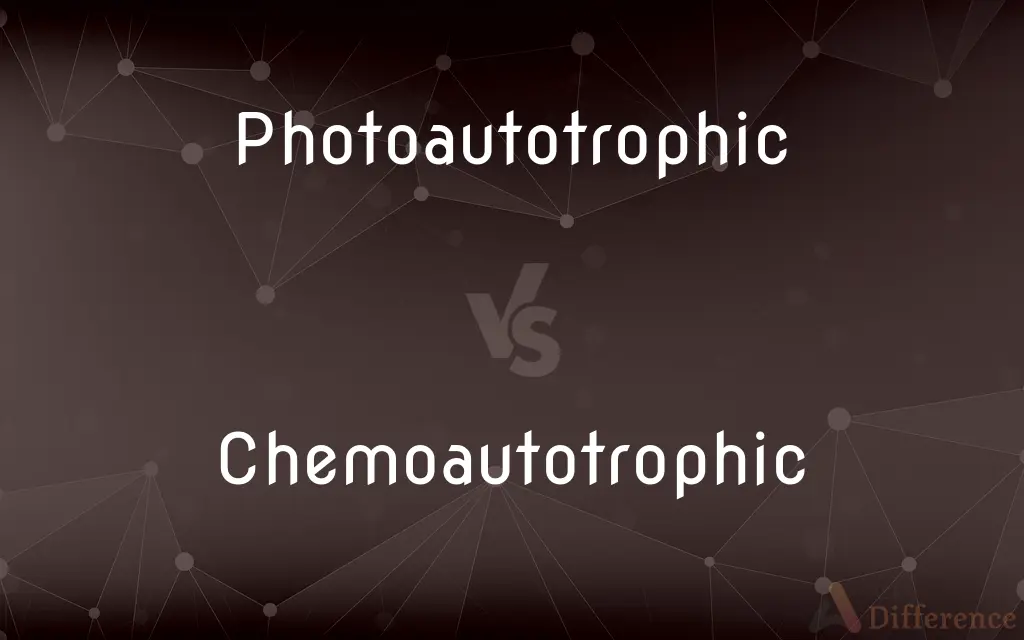Photoautotrophic vs. Chemoautotrophic — What's the Difference?
By Tayyaba Rehman — Published on January 31, 2024
Photoautotrophs use light as their energy source, while chemoautotrophs obtain energy from inorganic chemical reactions.

Difference Between Photoautotrophic and Chemoautotrophic
Table of Contents
ADVERTISEMENT
Key Differences
Photoautotrophs harness sunlight for energy, utilizing it in photosynthesis to convert CO2 and water into organic compounds. Chemoautotrophs, in contrast, rely on chemical reactions, often involving inorganic substances like hydrogen sulfide or ammonia, to produce energy. Both processes are autotrophic, meaning they generate their own food, but they differ fundamentally in their energy sources.
In ecosystems, photoautotrophs often form the primary producers, using light to create organic matter that sustains other organisms. Chemoautotrophs, however, thrive in environments devoid of sunlight, like deep-sea vents, deriving energy from chemical reactions. Both types are crucial for their respective ecosystems, driving primary productivity through different energy pathways.
Photoautotrophic organisms, like plants and algae, are pivotal in oxygen production, releasing oxygen as a byproduct of photosynthesis. Chemoautotrophs, on the other hand, do not contribute to oxygen production. Instead, they often play a role in nutrient cycling, especially in extreme environments.
The presence of photoautotrophs is often evident due to their green pigment, chlorophyll, which is essential for capturing light. Chemoautotrophs lack such pigments, as their energy acquisition doesn't involve light. This distinction reflects their adaptation to vastly different environments and energy sources.
In terms of evolutionary significance, photoautotrophs are responsible for shaping Earth's atmosphere and climate through oxygen production. Chemoautotrophs, while less visible, represent a fundamental aspect of life's adaptability, thriving in conditions previously thought uninhabitable and contributing to our understanding of extremophilic life.
ADVERTISEMENT
Comparison Chart
Energy Source
Light
Inorganic chemicals
Environment
Typically surface environments with sunlight
Extreme environments like deep-sea vents
Role in Ecosystem
Primary producers, oxygen generators
Nutrient cyclers, adapt to harsh conditions
Physical Characteristics
Contains chlorophyll for light absorption
Lacks pigments for light absorption
Impact
Crucial for atmospheric oxygen levels
Demonstrates life’s adaptability in extreme conditions
Compare with Definitions
Photoautotrophic
Photoautotrophic organisms are self-sustaining, using sunlight to produce their food.
The leaves of plants are the primary sites of photoautotrophic activity.
Chemoautotrophic
Chemoautotrophic organisms play a key role in nutrient cycling in harsh environments.
Sulfur-oxidizing bacteria are chemoautotrophic, contributing to sulfur cycling in nature.
Photoautotrophic
Photoautotrophs form the basis of most food chains by creating organic materials from light.
Forests are dominated by photoautotrophic trees that provide oxygen and food for other species.
Chemoautotrophic
Chemoautotrophs derive energy from chemical reactions, not dependent on sunlight.
Certain bacteria in deep-sea vents are chemoautotrophic, surviving in extreme conditions.
Photoautotrophic
Photoautotrophs convert light energy into chemical energy via photosynthesis.
Algae, a photoautotrophic organism, plays a key role in aquatic ecosystems.
Chemoautotrophic
Chemoautotrophs are foundational to ecosystems where light is absent or scarce.
In the dark depths of the ocean, chemoautotrophic microbes form the base of the food web.
Photoautotrophic
Photoautotrophic organisms often possess green pigments like chlorophyll for photosynthesis.
Grass, a common photoautotrophic plant, covers vast stretches of the Earth's surface.
Chemoautotrophic
Chemoautotrophs demonstrate life’s adaptability to extreme and varied conditions.
Chemoautotrophic organisms in hot springs showcase the diversity of life in extreme heat.
Photoautotrophic
Photoautotrophs are integral in carbon fixation, reducing CO2 levels in the atmosphere.
Phytoplankton, photoautotrophic in nature, significantly contribute to carbon cycling in oceans.
Chemoautotrophic
Chemoautotrophs obtain energy by oxidizing inorganic substances like hydrogen sulfide.
Hydrothermal vent bacteria, chemoautotrophic in nature, thrive on chemicals emitted by the vents.
Photoautotrophic
See phototroph.
Chemoautotrophic
See chemolithoautotroph.
Photoautotrophic
Relating to a photoautotroph or to photoautotrophism
Chemoautotrophic
Obtaining its nutrition through the oxidation of non-organic compounds (or other chemical processes); as opposed to the process of photosynthesis.
Common Curiosities
Can photoautotrophs survive without light?
No, photoautotrophs require light to perform photosynthesis and produce their food.
How do chemoautotrophs obtain energy?
Chemoautotrophs derive energy from chemical reactions involving inorganic substances.
Do photoautotrophs produce oxygen?
Yes, photoautotrophs release oxygen as a byproduct of photosynthesis.
What is the significance of photoautotrophs in food chains?
Photoautotrophs are primary producers, forming the base of most food chains by creating organic matter.
Are chemoautotrophs found in common environments?
Chemoautotrophs are primarily found in extreme environments like deep-sea vents, not typical habitats.
What pigments do photoautotrophs use for energy absorption?
Photoautotrophs commonly use chlorophyll to absorb light energy.
What defines a photoautotroph?
Photoautotrophs are organisms that use sunlight to synthesize nutrients from carbon dioxide and water.
Are all plants photoautotrophic?
Most plants are photoautotrophic, using photosynthesis to make their food, but some are exceptions.
Can photoautotrophs adapt to low-light conditions?
Some photoautotrophs can adapt to low-light conditions, but they still require some light for photosynthesis.
Do chemoautotrophs contribute to atmospheric oxygen?
No, chemoautotrophs generally do not contribute to atmospheric oxygen levels.
Can chemoautotrophs use photosynthesis?
No, chemoautotrophs do not use photosynthesis; they rely on chemical energy.
How do photoautotrophs impact the carbon cycle?
Photoautotrophs play a crucial role in the carbon cycle through carbon fixation during photosynthesis.
What role do chemoautotrophs play in the ecosystem?
Chemoautotrophs are crucial in nutrient cycling, especially in environments lacking sunlight.
What types of chemicals do chemoautotrophs often utilize?
Chemoautotrophs often use chemicals like hydrogen sulfide, methane, or iron for energy.
Are chemoautotrophs important for understanding extremophilic life?
Yes, chemoautotrophs are vital for studying life in extreme conditions and understanding extremophiles.
Share Your Discovery

Previous Comparison
Seal vs. Sea Lion
Next Comparison
Cellpadding vs. CellspacingAuthor Spotlight
Written by
Tayyaba RehmanTayyaba Rehman is a distinguished writer, currently serving as a primary contributor to askdifference.com. As a researcher in semantics and etymology, Tayyaba's passion for the complexity of languages and their distinctions has found a perfect home on the platform. Tayyaba delves into the intricacies of language, distinguishing between commonly confused words and phrases, thereby providing clarity for readers worldwide.












































